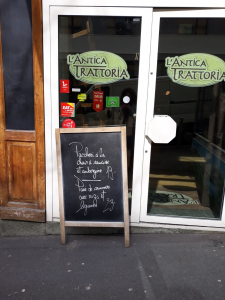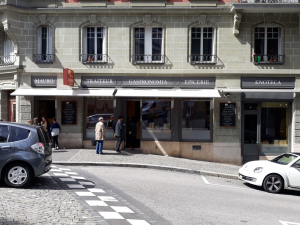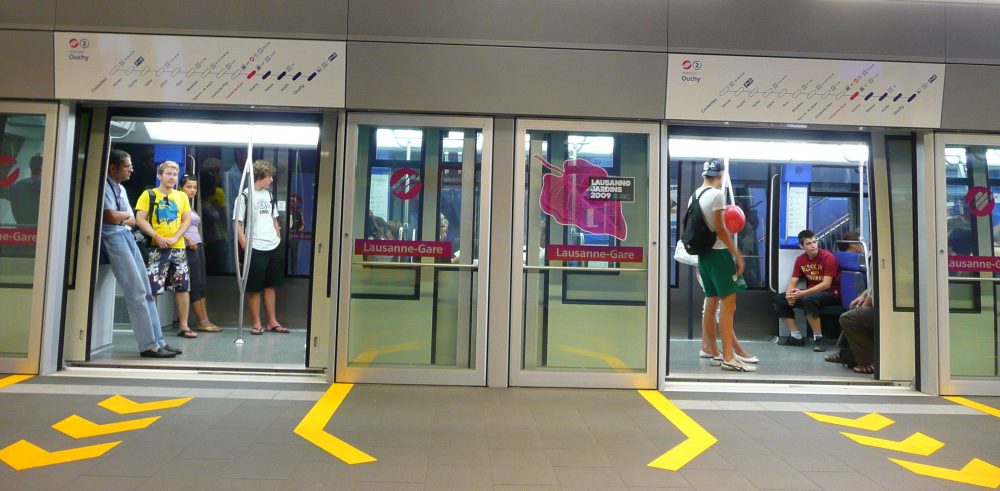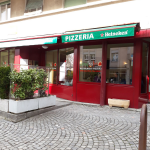Commercial Multilingualism in Lausanne:
An Investigation of Multilingualism in Marterey and Surroundings
Université de Lausanne, Kieran Bezençon & Camille Séris
Abstract
This article is part of a larger project associated with the seminar taught by Dr Maria Rosa Garrido Sardà at the University of Lausanne, Introduction to Multilingualism in Society. Our goal is to investigate how, why and where multilingualism occurs within the city of Lausanne, with a Linguistic Landscape approach. After exploring the city and selecting a specific area, we decided to work on commercial multilingualism, as defined by Pillar (2001), in the neighbourhood of Marterey and its surrounding streets. With a corpus of pictures showing a variety of languages, we observed that commercial multilingualism in restaurants could have several uses, such as signifying the type or quality of the food served, the history of place, and/or advertising a specific type of atmosphere to attract clients.
Introduction
As we have entered a time of globalisation and now live in a world of cultural exchanges, sociolinguists have found a new approach to study the various uses of languages. Indeed, when people move around the globe, not only do they bring with them their customs but they also carry their languages with their specific uses and the values associated with them. This lead to the creation of many multilingual places. These places are of great interest as they differ from the official bilingual places, where most of their population speaks both languages. Indeed, immigrants usually settle down in neighbourhoods with people of the same origins and create smaller versions of their home countries. Great examples of such neighbourhoods are “China Town” or “Little India”. These places are of interest to sociolinguists as they aim to recreate a familiar environment in comparison to places that are officially multilingual where it is mainly a question of expressing a national identity. These non-official multilingual places are nowadays very easy to find and so is the case of the city of Lausanne in Switzerland. Indeed, the country has been welcoming immigrants for a few generations now, and when looking closely, immigrant multilingualism can be found everywhere in the city. In this study, we will look at the case of Lausanne and we will focus on commercial multilingualism. The aim of the study is to uncover what languages are visible and how advertisers use the ideologies behind each of those languages to (re)create identities.
Theoretical framework
Research on linguistic landscape has increased in the last two decades. Thus, a quick overview of its aims and developments seems important in order to give some background information to the study. ‘Linguistic landscape’ was first used by sociolinguists to define the study of multilingualism through physical space (Landry and Bourhis 1997). In their article, they defined the term linguistic landscaping as “the language of public road signs, advertising billboards, streets names, place names, commercial signs, and public signs on government buildings [that forms] a given territory, region, or urban agglomeration”. (Landry and Bourhis 1997: 25). This definition was further developed by Shohamy and Gorter (2009) due to the impact of technologies on public spaces. They claimed that linguistic landscaping refers to the study of “language in the environment, words and images displayed and exposed in public spaces” (Shohamy and Gorter 2009: 1). Gorter latter extended the categories of signs to “electronic flat-panel display, LED neon lights, foam boards, electronic messages centres interactive touch screens, inflatable signage, and scrolling banners” (Gorter 2013: 191). Research on linguistic landscaping addresses multiple issues such as “meanings, functions, context of representations and symbolism of signs” (Kasanga 2012: 556). When comparing signs, their size, position and diverse functions of the languages are observed. This points out whether the languages used are representing duplicating, fragmentary, overlapping or/and complementary multilingualism (as in Reh (2004)). These functions can be classified in a sub-category introduced by Landry and Bourhis (1997) that describe the languages as either ‘informative’ or ‘symbolic’.
Researchers in this subfield of sociolinguistic have focussed their research within places of interest by strategically selecting neighbourhoods that were likely to present an interesting linguistic landscape. Kasanga (2012) described the phenomenon of ‘geographical centrality’ as “an opportunity for individuals and businesses to project their identities” (Kasanga 2012: 562). This ‘gentrification’ offers many rich linguistic landscapes thus, offering a great opportunity for researchers to discover what are the uses of languages in this field.
A way to investigate linguistic landscape is through commercial multilingualism. This approach consists of seeking multilingual signs which final goal is to sell something to a consumer. Whether the aim is to sell a service or a product, the advertising has to be well constructed in order to convince the ‘narratee’ (Goddard 1998) to buy the final product. This means that the advertiser has to strategically target his consumers in order to approach them the best way possible and sell his product or service. Piller (2001) reviewed multilingual advertising and its crucial role in the construction of identity. In her article, Piller studied the use of English and other foreign languages in German advertising. She started by mentioning the recent use of foreign languages next to the official language due to globalisation. She also found out that German was “relegated to the language of mundane factual information” whereas English was left “to do mainly symbolic work, to work through stereotypical associations with the language, its speakers, and the cultures where it is spoken” (Piller 2001: 180). This illustrates the concept of ‘informative’ versus ‘symbolic’ that Landry and Bourhis (1997) explored. This distinction, according to Piller, associates English with a special social class, ‘the young, cosmopolitan business elite’. These bilingual advertisements are thus, targeted to a specific reader. Piller also mentioned that English was used as the authoritative voice by being found in the headlines and in a larger, more visible fond. This phenomenon is very similar to the case of German-speaking Switzerland, where Lee (1992) found that slogans in Swiss adverts were in English to reinforce the authority and expertise associated with the language. To conclude, Piller argued that “in its multilingual practices, advertising shows an avant-garde-like readiness to embrace discourse of unsettled, hybrid identities as expressed through the use of different linguistic codes” (Piller 2001: 182). All of this points out the reasoning behind multilingualism in advertisements.
Another crucial point to understand this study is the symbolic of the languages used. For instance, the French language is often associated with beauty products. Goldstein studied the use of foreign languages in Japanese adverts and found that French was present in them but for “a decorative purpose by invoking an image – the mystique of France and the French language” (Goldstein 2011: 24). Italian is also a language found in advertisements without always being understood by the narratee. The case of Italian in food was studied by Girardelli (2004) and its representation in the United States. He found out that the Italian language was used as a medium to create ‘fake authenticity’. However, he also argued that the consummation of foreign cuisines is a form of acceptance of other cultures, as well as, even counterfeit, a celebration of the Italian values. This exemplifies the theory of advertising with language ideologies.
Contextualisation
For this study, the city of Lausanne was observed. As it is situated in the French-speaking part of Switzerland (the Romandie), the official language is French. However, when one strolls around the city, one can find a multitude of languages. Before giving hypothesis to explain this phenomenon, an overview of the language situation in Switzerland followed by one of the city of Lausanne are needed.
Switzerland is unique amongst other countries of Europe as it has four national languages (German, French, Italian and Romansch), three of which are used for official purposes. The important thing to stress is that the country is quadrilingual and not its inhabitants. This leaves the major part of Swiss people speaking one language, the official one in their region, plus one their learned in school. Yet, there is a rise of people speaking English, mainly the younger generations, due to the impact of globalisation. There also is the migrant population that moved to Switzerland bringing along their languages. This situation led to many shops, restaurants and other facilities opening while promoting their commerce in their native language(s) next to their new official language.
As mentioned before, the city of Lausanne accommodates many of these commercial places due to immigration. This phenomenon started in the 19th century with the railway network expanding its commerce. This first wave brought people mainly from neighbouring countries. The second wave of migrants attracted Italian and Spanish workers after the Second World War. This population of migrants stopped being attracted to Switzerland when their home countries’ economy improved. For the last 30 years, Switzerland attracted populations from Portugal and Yugoslavia and since the introduction of the free movement; ten thousands of workers came mainly from EU countries (Duc-Quang 2017). This lead Switzerland to be a linguistic melting pot, full of people expressing their identities by bringing along their culture and language(s). Classic examples of this migration recreating values and traditions from their home countries are restaurants and small shops selling products and food from their homeland. Indeed, food plays a great role in our construction of identity. The well-known saying ‘you are what you eat’ reflects the importance of food habits and their role as ‘cultural signifiers’ (Almerico 2014). This explains why it is very popular to bring and recreate food habits as foreigners and Lausanne is not an exception to this phenomenon, the city is actually very familiar with the practice, as we will see later.
The neighbourhood selected for this study was Marterey. Not only the streets of the neighbourhood and its surroundings accommodate many food places from various countries, it also shows a sense of neighbourhood community. In this community, we can find many Italians that moved to Switzerland in the second half of the 20th century. These people are rather well integrated into the neighbourhood. It is also worth mentioning the recent appeal for East-Asian culture from Swiss people, thus, attracting people from these countries.
Method
The data for this article were collected as part of a larger study on multilingualism in the city of Lausanne. The data for this article were collected on two trips around the city of Lausanne during the month of April 2018. The first trip allowed us to get a general idea of where the linguistically interesting places were situated in Lausanne. After, this first trip, we gathered our data and selected one neighbourhood which was interesting for the topic we choose. This neighbourhood was Marterey and its surroundings, situated in the city centre. We decided to focus only on commercial places such as restaurant due to their profusion in the neighbourhood. During this first trip, we took photos of every shops, to gather a first data base of the area. A second trip allowed us to get clearer images of the places to exemplify our results by getting detailed observations.
Once the results all gathered, we classified them into different categories. First was the language used, then the support it was on, followed by the type of sign and lastly, the production of the sign (top-down, bottom-up). This method allowed us to get a clear overview of how multilingualism was represented in the neighbourhood of Marterey.
This method of data collecting was very interesting to do. The hunt for multilingualism within the city to find a place with great potential for this study turned out to be a rediscovery of Lausanne. Indeed, whilst strolling around the streets, our eyes were looking at each and every details and a new image of Lausanne popped up in front of us. We realised that many places were often left unseen. This is why looking for as many details as we could, appeared like a game. Another nourishing aspect of this fieldwork was the try to uncover the mechanisms that people used to project their image on the streets. Finally, this study allowed us to get a clear insight of the multiplicity of identities in the city of Lausanne.
Results
From our exploration of Marterey, we were able to create a corpus of 12 pictures, representative of what one could notice when strolling in the streets of the neighbourhood. However, this corpus does not contain every instance of multilingualism; it is only a sample that can be used to give an idea of the overall use of languages within this specific area. Those are multilingual instances because they are situated in a French speaking region and are near other shops, signs and indications written in French. The presence of another language in contact of French can thus be described as multilingualism. All of those occurrence are top-down multilingualism, meaning their were created by the owner of the shop for a specific purpose, which is commercial multlingualism.
The data collected showed 58 percent of Italian multilingualism (7 pictures), 25 percent of Chinese multilingualism (3 pictures), 8.5 percent of Spanish (1 picture), and 8.5 percent of English (1 picture). It is important to note that those are restaurants who showed clear multilingualism signs on their outside space for commercial purposes. We decided to not compare the numbers between foreign language commercial multilingualism with French-only, as the focus of our study was only on the presence of multilingualism and its uses.
Our data was composed of a majority of restaurants (58%), with 43 percent of being pizzeria-restaurant places, one ice-cream shop, one caterer, one pub, one takeaway and one cake shop. The languages observed can be distributed through these shops as it follows: Italian was found on 71 percent of the restaurants (100% of restaurant-pizzeria), the caterer as well as the ice cream seller. Chinese was used for 29 percent of the restaurants and the takeaway. Spanish was present on the window of the cake-shop. Lastly, English was used for the pub. In the discussion we will focus on the italian multilingualism, as it is the most visible and present in the area, in order to see how it is used for a commercial purpose.
Discussion
As previously mentioned, we focused our research on restaurants in Marterey and its surroundings. Not only we looked at the languages that we were able to find, we also thought about the values these languages added and why they were efficient as a form of commercial multilingualism.
First, we noticed that Italian was used in more than half of our corpus, showing a predominance in this specific street. This corresponds to the previously mentioned Italian immigration wave, with the possibility that Italians moving in Lausanne at the time started these restaurants. Even though most of the observed Italian restaurant seemed to be only family-friendly restaurant, probably using Italian to sell their atmosphere as convivial, some seemed to have a different purpose. The restaurant-pizzeria Bravissimo (see Image 1), described as a “pizzeria” (a loan-word from Italian in many languages nowadays), is typical of the small street restaurant. Situated in the middle of the street, with little outdoor space, it could be a place where workers or members of the Italian community often go to. However, those are information we do not dispose of, as we did not have the time to have a sit inside and wait to see what kind of customers this place attracts.
Image 1: Restaurant-Pizzeria Bravissimo, rue Martery 25
This use of the Italian language, further than just being an indicator of an Italian gastronomy or customers, also reflects an idea of good quality and good food services, as the Italians are well-known for it. Thus, a restaurant displaying some Italian words on its outside could be a strategy to attract more clients or a better class of clients. Looking at a second example, the restaurant L’antica Trattoria (see Image 2), we immediately see a difference in appearance. The restaurant is placed at an intersection, making it more visible, and has a better exterior presentation. In addition, the Italian name, meaning the “ancient caterer”, thus symbolizing a sort of authenticity and quality by mentioning a tradition, works with this strategic and commercial appearance of the restaurant, which is promising a quality service with only its looks.

Image 2: Restaurant L’Antica Trattoria, Rue Marterey 9
Furthermore, one restaurant in our data seems to have a combination of those values. The Mauro Traiteur, which has written “gastronomia” (“gastronomy” in Italian) and “enoteca” (“wine shop” in Italian) on its outside, combines the idea of a place run by Italians with the idea of a specific food quality. Indeed, on the restaurant website, we can see the owners referring to his wife and himself as “les italiens de Marterey” (“the Italians of Marterey” in French) as well as “gastronomie italienne” (“Italian gastronomy” in French) when referring to their food, and a family run restaurant as it was originally Mauro and his wife who took care of it.

Image 4: Mauro traiteur, Rue de l’Ancienne-Douane 4
The second main type of language that we found was Chinese. Remembering what we previously said, that there was a recent appeal from Swiss people towards East-Asian culture (such interest not being limited to Swiss people, but rather being a global phenomenon where Asian culture travels around the world), such presence does not surprise us. The presence of multilingual signs shows an authenticity of the food served, and a quality linked to this specific type of food. It is true, and the same goes for the Italian type of multilingualism, when you see such signs you expect to find a certain type of food.
Conclusion
This project about multilingualism, linked to our course at the University of Lausanne and the creation of a blog about multilingualism in Lausanne, led us to an investigation of commercial multilingualism in a specific area, namely Marterey and its surrounding streets. During our observation, we collected a dataset of twelve photos, showing, on one hand, a dominance of Italian multilingualism on restaurants and, on the other hand, a great variety of other languages such as Chinese, English, and Spanish. Some languages seems propitious for commercial multilingualism, as the one we have seen in our area, when other seems to be invisible or just transalted in French. This was not discussed as it was not the case in Marterey, but it would be interesting to investigate what languages are used and not used for commercial purpose in language and why. We also saw that languages can have various signification, based on stereotypes or other symbolic constructions, more than simply indicating the type of food served. Either symbolising the quality of the food, the service, the atmosphere of the restaurant, or even referring to the origins of the owner, multilingualism in commerce can, as seen in this essay, serve to index and create authenticity to the culture of the language. Even though this study was focused on multilingualism, it could have been interesting to compare the number of French-only restaurant to see what would the percentage of this linguistic phenomenon be. Furthermore, investigating the interior of the restaurants, the way they were decorated and/or what kind of music was played in, or even to speak with some employees, could have brought more details and push further the reflexion. Even so, this study, and those of our comrades, has permitted to show that multilingualism is present in Lausanne, in different places and forms and for different purposes.
References
Almerico, G. M. 2014. Food and identity: Food studies, cultural, and personal identity. Journal of International Business and Cultural Studies 8, 1-7. Bottazzi, M. Retrieved on: http://www.maurotraiteur.com/accueil/ (consulted on 02.06.2018)
Duc-Quang, N. 2017. Retrieved on: https://www.swissinfo.ch/eng/society/willkommen-bienvenue_switzerland-land-of-european-immigration/42941390 (consulted on 25.06.2018)
Girardelli, D. 2004. Commodified Identities: The Myth of Italian Food in the United States. Journal of Communication Inquiry. 28:4, 307-324.
Goddard, A. 1998. The language of advertising: Written texts. London & New York: Routledge.
Gorter, D. 2013. “Linguistic Landscape in a Multilingual World.” Annual Review of Applied Linguistics 33, 190-212.
Kasanga, L. A. 2012. Mapping of the linguistic landscape of a commercial neighbourhood in Central Phnom Penh. Journal of Multilingual and Multicultural Development 33:6, 553-567.
Landry, R. and R. Y. Bourhis, 1997. Linguistic landscape and ethnolinguistic vitality: An empirical study. Journal of Language and Social Psychology 16: 1, 23-49.
Lee, D. 1992. Competing discourses: Perspective and ideology in language. London: Longman.
Piller, I. 2001. Identity constructions in multilingual advertising. Language in Society 30, 153-186.
Reh, M. 2004. “Multilingual Writing: A Reader-Oriented Typology – With Examples from Lira Municipality (Uganda).” International Journal for the Sociology of Language 170, 1-41.
Shohamy, E. and D. Gorter, 2009. Linguistic landscape: Expanding the scenery. London: Routledge.

